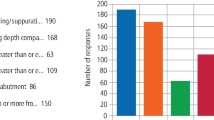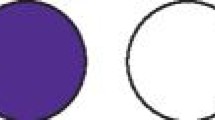Abstract
Aims The study primarily assessed the efficacy of different communication methods on patients' comprehension and recall of knowledge relating to peri-implantitis. Secondarily, the study assessed the effect of different communication methods on patients' beliefs in line with the health belief model.
Design A prospective randomised controlled trial
Methods Ninety-nine patients with a diagnosis of peri-implantitis were recruited over 25 months. They were randomly allocated to one of three arms of the trial. Group one was given a leaflet with visual aids, group two a leaflet with no visual aids and group three verbal information only. A questionnaire was used to assess their understanding and retention of knowledge relating to peri-implantitis at baseline, three months and six months. Secondly, the questionnaire assessed the influence of the communication strategy on the components of the 'health belief model' relating to peri-implantitis - perceived severity, susceptibility, benefits, barriers, self-efficacy and behavioural intentions.
Results Of the 99 patients who were initially recruited, 85 remained at three months and 78 at six months. At baseline, group one (who were provided with a leaflet and visual aids) showed better comprehension when compared to the other groups. This was statistically significant. However, there was no statistically significant difference in recall of information at three and six months, between any group. Questions relating to the health belief model showed there was statistical significance in the control group who perceived the barriers to good implant hygiene to be more difficult than both test groups. There was some statistical significance in the perceived susceptibility to peri-implantitis between groups.
Conclusion The use of leaflets with visual aids as a communication strategy appears to improve patient comprehension of information regarding factors associated with peri-implantitis in the short term in this patient group. However, it does not appear to translate to improved recall of the same information at follow-up.
This is a preview of subscription content, access via your institution
Access options
Subscribe to this journal
Receive 4 print issues and online access
$259.00 per year
only $64.75 per issue
Buy this article
- Purchase on Springer Link
- Instant access to full article PDF
Prices may be subject to local taxes which are calculated during checkout
Similar content being viewed by others
References
Mombelli A, Muller N, Cionca N. The epidemiology of peri-implantitis. Clin Oral Implants Res 2012; 23: 67-76.
General Dental Council. Standards for the Dental Team. London: General Dental Council, 2013.
Dental Complaints Service. Review 2022. London: General Dental Council, 2020.
Parliamentary and Health Service Ombudsman. Poor communication is at heart of many dental complaints, finds ombudsman. 2015. Available at https://www.ombudsman.org.uk/news-and-blog/news/poor-communication-heart-many-dental-complaints-finds-ombudsman (accessed April 2022).
Shing Y L, Brod G. Effects of Prior Knowledge on Memory: implications for education. Mind Brain Educ 2016; 10: 153-161.
Author information
Authors and Affiliations
Ethics declarations
The authors declare no conflict of interest.
Rights and permissions
About this article
Cite this article
Linden, J., Fletcher, R. 'Implanting' knowledge - how best to aid patient understanding and retention of information regarding peri-implantitis. Evid Based Dent 23, 66–67 (2022). https://doi.org/10.1038/s41432-022-0270-y
Received:
Accepted:
Published:
Issue Date:
DOI: https://doi.org/10.1038/s41432-022-0270-y



